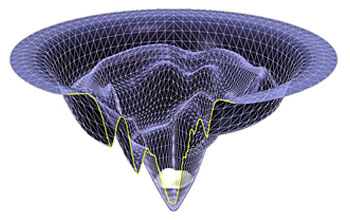Media Advisory 11-023
Researchers Discuss Sustainability, the Physics of Living Systems and the World Beyond
Mathematical and Physical Sciences lecture series for 2011-12 begins Monday, November 7

Current research aims to explain what shapes of energy landscapes lead to foldable proteins.
October 26, 2011
This material is available primarily for archival purposes. Telephone numbers or other contact information may be out of date; please see current contact information at media contacts.
The National Science Foundation's (NSF) Directorate for Mathematical and Physical Sciences invites media and members of the public to attend a series of lectures that aims to promote discussion of national issues that scientists expect to shape their research in the coming years.
The first talk on Monday, November 7, will feature Massachusetts Institute of Technology (MIT) Professor of Materials Science and Engineering Gerbrand Ceder, who will discuss "The Materials Project," formerly the Materials Genome program at MIT, an approach that aims to design materials with advanced properties through an interactive combination of computational, theoretical and experimental research.
All lectures will be held at NSF, 4201 Wilson Boulevard in Arlington, Va., which is easily accessible from the Ballston Metro station. Visitors are welcome.
Complete Schedule of Lectures
Large-Scale Computational Materials Design: The Materials Genome Program at MIT
Gerbrand Ceder, MIT
November 7 at 2 p.m., Room 110
A Mathematical Look at the Dynamics of the Unconscious Brain Under General Anesthesia
Emery Brown, Harvard University and MIT
December 19 at 2 p.m., Room 110
Role of Science In Moving the Planet to Green Energy and a Sustainable Future
Emily Carter, Princeton University
January 20 at 2 p.m., Room 110
Landscapes and Beyond: From Physics and Protein Folding to Modeling Active Biological Matter
Peter Wolynes, Rice University
March 19 at 2 p.m., Room 110
Demographics of Exoplanets
Scott Gaudi, Ohio State University
April 16 at 2 p.m., Room 110
Creating Economic Value From University Science: What is the Role of Faculty?
Angus Kingon, Brown University
May 21 at 2 p.m., Room 110
Bringing Chemistry to Life: Bioorthogonal Chemistries for Glycoprofiling and Beyond
Carolyn Bertozzi, University of California, Berkeley
June 25 at 2 p.m., Room 110
About the Directorate for Mathematical and Physical Sciences
The Mathematical and Physical Sciences directorate comprises the divisions of Astronomical Sciences, Chemistry, Materials Research, Mathematical Sciences, Physics and the Office of Multidisciplinary Activities. These divisions provide the basic structure for support of disciplinary and interdisciplinary research and education. The scope of scientific and educational activity supported is enormous, ranging from phenomena at cosmological distances, to environmental science on the human scale, through quantum mechanical processes in atomic and subatomic physics, to phenomena of the unimaginably small. Researchers explore abstract ideas, concepts, and structures of mathematics as well as more tangible "stuff" that includes the materials used in our everyday lives. Their tools range from desktop instruments to synchrotron light sources, accelerators, radio and optical telescopes and high magnetic fields. The rapid development of computational and communications capabilities also is leading to the development of a new set of tools that support data-enabled science.
-NSF-
Media Contacts
Lisa Van Pay, NSF, (703) 292-8796, email: lvanpay@nsf.gov
Program Contacts
Andrew J. Lovinger, NSF, (703) 292-4933, email: alovinge@nsf.gov
Related Websites
Mathematics and the Physical Sciences Directorate: http://www.nsf.gov/dir/index.jsp?org=MPS
The U.S. National Science Foundation propels the nation forward by advancing fundamental research in all fields of science and engineering. NSF supports research and people by providing facilities, instruments and funding to support their ingenuity and sustain the U.S. as a global leader in research and innovation. With a fiscal year 2023 budget of $9.5 billion, NSF funds reach all 50 states through grants to nearly 2,000 colleges, universities and institutions. Each year, NSF receives more than 40,000 competitive proposals and makes about 11,000 new awards. Those awards include support for cooperative research with industry, Arctic and Antarctic research and operations, and U.S. participation in international scientific efforts.
Connect with us online
NSF website: nsf.gov
NSF News: nsf.gov/news
For News Media: nsf.gov/news/newsroom
Statistics: nsf.gov/statistics/
Awards database: nsf.gov/awardsearch/
Follow us on social
Twitter: twitter.com/NSF
Facebook: facebook.com/US.NSF
Instagram: instagram.com/nsfgov


